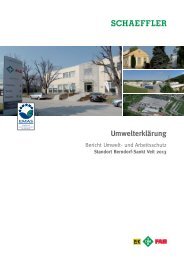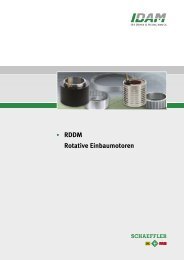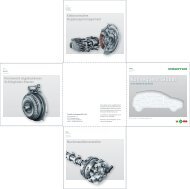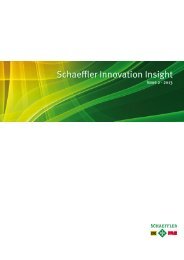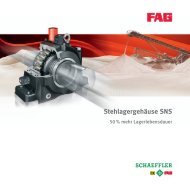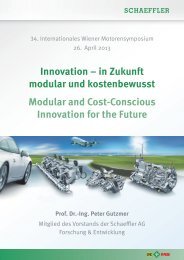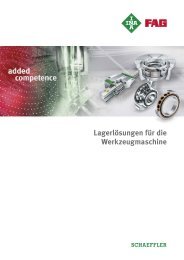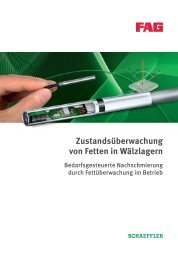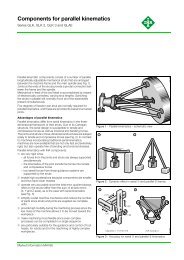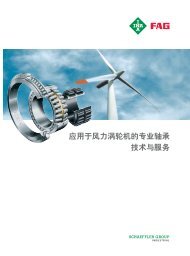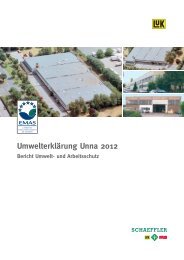Thermal management at Schaeffler: How much water does an ...
Thermal management at Schaeffler: How much water does an ...
Thermal management at Schaeffler: How much water does an ...
Create successful ePaper yourself
Turn your PDF publications into a flip-book with our unique Google optimized e-Paper software.
22 <strong>Thermal</strong> <strong>m<strong>an</strong>agement</strong><br />
22 <strong>Thermal</strong> <strong>m<strong>an</strong>agement</strong><br />
<strong>Thermal</strong> <strong>m<strong>an</strong>agement</strong><br />
22<br />
<strong>Thermal</strong> <strong>m<strong>an</strong>agement</strong> <strong>at</strong> <strong>Schaeffler</strong><br />
<strong>How</strong> <strong>much</strong> w<strong>at</strong>er <strong>does</strong> <strong>an</strong> engine need?<br />
Elmar Mause<br />
Eduard Golov<strong>at</strong>ai-Schmidt<br />
Markus Popp<br />
Sebasti<strong>an</strong> Hurst<br />
22<br />
302<br />
<strong>Schaeffler</strong> SYMPOSIUM 2010<br />
<strong>Schaeffler</strong> SYMPOSIUM 2010<br />
303
22 <strong>Thermal</strong> <strong>m<strong>an</strong>agement</strong><br />
<strong>Thermal</strong> <strong>m<strong>an</strong>agement</strong><br />
22<br />
<strong>Thermal</strong> <strong>m<strong>an</strong>agement</strong> is <strong>an</strong> import<strong>an</strong>t factor for<br />
reducing CO 2<br />
emissions. This article presents<br />
the reasons for the use of a thermal <strong>m<strong>an</strong>agement</strong><br />
system, <strong>an</strong> <strong>an</strong>alysis of the requirements<br />
<strong>an</strong>d <strong>an</strong> approach for implementing such a system.<br />
<strong>Thermal</strong><br />
<strong>m<strong>an</strong>agement</strong><br />
The term “thermal <strong>m<strong>an</strong>agement</strong>” describes the<br />
efficient control of thermal energy flows in the<br />
vehicle in accord<strong>an</strong>ce with the specific requirements<br />
<strong>an</strong>d the prevailing oper<strong>at</strong>ing <strong>an</strong>d load<br />
conditions. As a result, vehicle emissions c<strong>an</strong> be<br />
reduced, <strong>an</strong>d the thermodynamic <strong>an</strong>d mech<strong>an</strong>ical<br />
engine efficiency c<strong>an</strong> be improved. This leads<br />
to lower fuel consumption, a longer engine life<br />
<strong>an</strong>d improved thermal comfort.<br />
0<br />
10<br />
20<br />
30<br />
40<br />
50<br />
60<br />
Load L in %<br />
70<br />
80<br />
90<br />
100<br />
6000<br />
5000<br />
4000<br />
Low load <strong>an</strong>d low speed: high cool<strong>an</strong>t temper<strong>at</strong>ure<br />
High load: low cool<strong>an</strong>t temper<strong>at</strong>ure<br />
High speed: low cool<strong>an</strong>t temper<strong>at</strong>ure<br />
The cool<strong>an</strong>t temper<strong>at</strong>ure should ideally be adjusted<br />
depending on the oper<strong>at</strong>ing condition of the<br />
engine (Figure 1).<br />
During cold start, the combustion engine should<br />
he<strong>at</strong> up rapidly in order to achieve a signific<strong>an</strong>t reduction<br />
in friction. Rapid he<strong>at</strong>ing of the engine oil<br />
<strong>an</strong>d the resulting decrease in oil viscosity are the<br />
decisive factors. The he<strong>at</strong> gener<strong>at</strong>ed by the engine<br />
must therefore not be dissip<strong>at</strong>ed by the cool<strong>an</strong>t<br />
but used for he<strong>at</strong>ing the engine oil.<br />
At low <strong>an</strong>d medium loads, high cool<strong>an</strong>t temper<strong>at</strong>ures<br />
(approx. 110 °C) are desirable for further reducing<br />
the engine friction.<br />
In addition to the above adv<strong>an</strong>tages, the acoustics<br />
of diesel engines c<strong>an</strong> be improved by reducing the<br />
ignition delay time. Intelligent thermal <strong>m<strong>an</strong>agement</strong><br />
c<strong>an</strong> influence the evapor<strong>at</strong>ion r<strong>at</strong>e <strong>an</strong>d thus<br />
the ignition delay.<br />
To prevent knocking of the gasoline engine <strong>an</strong>d<br />
reduce the enrichment of the mixture, the<br />
cool<strong>an</strong>t temper<strong>at</strong>ure<br />
should preferably be<br />
reduced (to approx.<br />
80 °C) <strong>at</strong> high loads<br />
<strong>an</strong>d high speeds.<br />
Intermedi<strong>at</strong>e stages<br />
110 must be defined between<br />
the two limit<br />
100<br />
values for the cool<strong>an</strong>t<br />
90 temper<strong>at</strong>ure. These<br />
80 vary depending on the<br />
70 combustion engine<br />
<strong>an</strong>d c<strong>an</strong> serve diverse<br />
60<br />
goals (reduced friction,<br />
optimized com-<br />
50<br />
40 bustion, lower raw<br />
30 emissions, increased<br />
comfort etc.).<br />
20<br />
1000 The ideal thermal <strong>m<strong>an</strong>agement</strong><br />
system should<br />
2000<br />
3000<br />
be able to adjust the<br />
relev<strong>an</strong>t cool<strong>an</strong>t temper<strong>at</strong>ure<br />
in accord<strong>an</strong>ce<br />
with the above requirements.<br />
<strong>Thermal</strong> <strong>m<strong>an</strong>agement</strong><br />
measures c<strong>an</strong> achieve<br />
fuel savings of up to<br />
4 % in the NEDC (Fig-<br />
eng<br />
Speed n in 1/min<br />
Figure 1 Required cool<strong>an</strong>t temper<strong>at</strong>ure depending on load <strong>an</strong>d speed from [1]<br />
Cool<strong>an</strong>t temper<strong>at</strong>ure T in °C<br />
ure 2). The blue curve<br />
shows the accumul<strong>at</strong>ed<br />
consumption of a<br />
reference engine, the<br />
red curve th<strong>at</strong> of <strong>an</strong><br />
engine with a thermal<br />
<strong>m<strong>an</strong>agement</strong> system.<br />
The green curve indic<strong>at</strong>es<br />
the savings in<br />
percentage terms th<strong>at</strong><br />
c<strong>an</strong> be achieved in the<br />
NEDC with the thermal<br />
<strong>m<strong>an</strong>agement</strong> system.<br />
Signific<strong>an</strong>t savings potentials<br />
of more th<strong>an</strong><br />
4 % c<strong>an</strong> be expected<br />
particularly in shortdist<strong>an</strong>ce<br />
driving oper<strong>at</strong>ion.<br />
This is mainly<br />
due to a more rapid<br />
he<strong>at</strong>-up of the engine<br />
<strong>an</strong>d the corresponding<br />
reduction in friction.<br />
Figure 3 gives <strong>an</strong> impression<br />
of the possible<br />
reduction in engine<br />
friction. If the oil<br />
temper<strong>at</strong>ure increases<br />
from 20 °C to 80 °C,<br />
the total frictional<br />
torque of the engine<br />
Cumulave consumpon C in kg<br />
0,8<br />
0,7<br />
0,6<br />
0,5<br />
0,4<br />
0,3<br />
0,2<br />
0,1<br />
Friconal torque M total in %<br />
100<br />
80<br />
60<br />
40<br />
20<br />
0<br />
Speed<br />
v in km/h<br />
-40<br />
-10<br />
20<br />
50<br />
80<br />
110<br />
140<br />
Oil temper<strong>at</strong>ure T in °C<br />
oil<br />
0<br />
0<br />
120<br />
60<br />
No<br />
cooling<br />
Cooling<br />
in accord<strong>an</strong>ce with requirements<br />
0<br />
0 120 240 360 480 600 720 840 960 1080 1180<br />
Time t in s<br />
Cumulave consumpon without thermal <strong>m<strong>an</strong>agement</strong><br />
Cumulave consumpon with thermal <strong>m<strong>an</strong>agement</strong><br />
Savings with thermal <strong>m<strong>an</strong>agement</strong><br />
0 120 240 360 480 600 720 840 960 1080 1180<br />
Time t in s<br />
NEDC<br />
Figure 2 Savings due to thermal <strong>m<strong>an</strong>agement</strong> from [2]<br />
5000<br />
3000<br />
1000<br />
eng<br />
Engine speed n in 1/min<br />
Figure 3 Reduction in engine friction from [3]<br />
decreases by 75 %. At <strong>an</strong> oil temper<strong>at</strong>ure of<br />
110 °C, it decreases by as <strong>much</strong> as 85 %. This<br />
shows th<strong>at</strong> rapid he<strong>at</strong>ing of the engine oil <strong>an</strong>d oper<strong>at</strong>ing<br />
the engine <strong>at</strong> the highest possible temper<strong>at</strong>ure<br />
make a signific<strong>an</strong>t contribution to reducing<br />
friction <strong>an</strong>d therefore fuel consumption.<br />
Friconal torque M<br />
total<br />
in %<br />
40<br />
30<br />
20<br />
10<br />
3500 1/min<br />
0<br />
-10 20 50 80<br />
Oil temper<strong>at</strong>ure T in °C<br />
oil<br />
8<br />
7<br />
6<br />
5<br />
4<br />
3<br />
2<br />
1<br />
75 % 85 %<br />
Reducon in consumpon C in %<br />
red<br />
110<br />
22<br />
304 <strong>Schaeffler</strong> SYMPOSIUM 2010<br />
<strong>Schaeffler</strong> SYMPOSIUM 2010 305
22 <strong>Thermal</strong> <strong>m<strong>an</strong>agement</strong><br />
<strong>Thermal</strong> <strong>m<strong>an</strong>agement</strong><br />
22<br />
Components for<br />
thermal <strong>m<strong>an</strong>agement</strong><br />
All components in the cooling circuit as shown in<br />
Figure 4 – radi<strong>at</strong>or, f<strong>an</strong>, louvers, thermost<strong>at</strong>, engine<br />
control unit, <strong>an</strong>d w<strong>at</strong>er pump – must in principle be<br />
included in the thermal <strong>m<strong>an</strong>agement</strong> system.<br />
These components are currently characterized by a<br />
limited variability.<br />
For example, there are thermost<strong>at</strong>s th<strong>at</strong> are controlled<br />
by me<strong>an</strong>s of wax elements. Switchable or<br />
electrically-driven w<strong>at</strong>er pumps are also being<br />
used. The cooling air flow c<strong>an</strong> be limited by splitting<br />
the radi<strong>at</strong>or into several parts or covering it<br />
with louvers. Solutions have been developed for<br />
the f<strong>an</strong> th<strong>at</strong> are similar to those for the w<strong>at</strong>er<br />
pump (electrically-driven f<strong>an</strong>, viscous coupling<br />
etc.).<br />
<strong>How</strong>ever, almost all vehicles today still use uncontrolled,<br />
mech<strong>an</strong>ically-driven w<strong>at</strong>er pumps.<br />
These are perm<strong>an</strong>ently linked with the engine<br />
speed via the belt drive <strong>an</strong>d therefore allow no<br />
variability. Presented below is a controllable w<strong>at</strong>er<br />
pump th<strong>at</strong> possesses the required variability.<br />
The variably adjustable flow r<strong>at</strong>e enables <strong>an</strong> additional<br />
degree of freedom for the cooling system.<br />
Controllable cool<strong>an</strong>t pump<br />
Engine control unit (ECU)<br />
Thermost<strong>at</strong><br />
W<strong>at</strong>er pump<br />
Figure 4 Components of thermal <strong>m<strong>an</strong>agement</strong> from [1]<br />
Pump open<br />
Solenoid<br />
(schemac)<br />
Pump closed<br />
Figure 5<br />
Pulley<br />
Shroud<br />
Impeller<br />
Cover<br />
pl<strong>at</strong>e<br />
Push rod<br />
Sealing Flo<strong>an</strong>g ring seal<br />
W<strong>at</strong>er pump bearing<br />
Return spring<br />
Design of a controllable w<strong>at</strong>er pump<br />
The controllable cool<strong>an</strong>t pump is a centrifugal<br />
pump with a shroud th<strong>at</strong> is integr<strong>at</strong>ed in the rotor<br />
as shown in Figure 5. A defined width of the<br />
rotor is exposed when the shroud is moved axially.<br />
This enables adjustment of the volume<br />
flow.<br />
If the shroud is in the left position (Figure 5, top<br />
diagram), the rotor width is completely exposed<br />
<strong>an</strong>d the gener<strong>at</strong>ed<br />
volume flow achieves<br />
Radi<strong>at</strong>or<br />
a maximum. The solenoid,<br />
which is loc<strong>at</strong>ed<br />
on the left side <strong>an</strong>d<br />
serves as <strong>an</strong> actu<strong>at</strong>or,<br />
Louvers is not fed with current.<br />
If the volume<br />
flow is to be reduced,<br />
the solenoid is fed<br />
with a defined amount<br />
of current. The arm<strong>at</strong>ure<br />
is correspondingly<br />
moved to the right,<br />
F<strong>an</strong><br />
presses against the<br />
push rod <strong>an</strong>d thus<br />
moves the shroud to<br />
the right. This reduces<br />
the effective width of the flow ch<strong>an</strong>nel <strong>an</strong>d cuts<br />
the flow (Figure 5, bottom diagram).<br />
To ensure the fail-safe function in case of a failure<br />
of the solenoid, a compression spring retains<br />
the shroud in the completely opened<br />
pump position. The compression spring is designed<br />
so as to ensure th<strong>at</strong> the w<strong>at</strong>er pump is<br />
completely opened when the flow forces reach<br />
a maximum.<br />
Flow r<strong>at</strong>e Q in %<br />
80<br />
60<br />
40<br />
20<br />
0<br />
Figure 6<br />
0 20 40 60 80 100<br />
Closing rao S in %<br />
1500 1/min<br />
3000 1/min<br />
4500 1/min<br />
Flow r<strong>at</strong>e in rel<strong>at</strong>ion to pump closing r<strong>at</strong>io<br />
<strong>an</strong>d speeds<br />
Figure 6 shows the flow behavior of the pump <strong>at</strong><br />
different closing r<strong>at</strong>ios <strong>an</strong>d speeds. A closing r<strong>at</strong>io<br />
of 0 % corresponds to a completely opened<br />
pump. The pump is<br />
closed <strong>at</strong> a closing r<strong>at</strong>io<br />
of 100 %. The diagram<br />
indic<strong>at</strong>es th<strong>at</strong><br />
the flow r<strong>at</strong>e decreases<br />
signific<strong>an</strong>tly with<br />
increasing closing r<strong>at</strong>ios.<br />
The flow r<strong>at</strong>e c<strong>an</strong> Nominal speed<br />
therefore be adjusted<br />
by the position of the<br />
shroud.<br />
Figure 7 shows the<br />
pump efficiency in<br />
rel<strong>at</strong>ion to the flow<br />
r<strong>at</strong>e <strong>at</strong> a speed of<br />
2500 1/min. The diagram<br />
indic<strong>at</strong>es th<strong>at</strong><br />
Low speeds<br />
the maximum efficiency<br />
<strong>at</strong> this speed is<br />
achieved when the<br />
pump is approx. 50 %<br />
open. This c<strong>an</strong> be Figure 8<br />
Efficiency η in %<br />
60<br />
50<br />
40<br />
30<br />
20<br />
10<br />
0<br />
Figure 7<br />
2500 1/min<br />
0 10 20 30 40 50 60 70 80<br />
Flow r<strong>at</strong>e Q in l/min<br />
0 % closed<br />
25 % closed<br />
50 % closed<br />
75 % closed<br />
Pump efficiency in rel<strong>at</strong>ion to flow r<strong>at</strong>e <strong>an</strong>d<br />
closing r<strong>at</strong>io<br />
<strong>at</strong>tributed to backflows <strong>an</strong>d turbulences th<strong>at</strong><br />
sometimes occur outside the design point (Figure<br />
8).<br />
At nominal speed, the complete rotor width is<br />
used for pumping the medium. At low speeds,<br />
backflows occur in the conventional pump (Figure<br />
8, left column) <strong>an</strong>d reduce the efficiency.<br />
When using a shroud, the rotor width c<strong>an</strong> always<br />
be adjusted to the required volume flow (Figure<br />
8, right column). This prevents energy loss<br />
caused by backflows <strong>an</strong>d therefore increases the<br />
efficiency of the pump.<br />
Convenonal pump<br />
Controllable pump<br />
Comparison of conventional <strong>an</strong>d controllable w<strong>at</strong>er pumps<br />
22<br />
306 <strong>Schaeffler</strong> SYMPOSIUM 2010<br />
<strong>Schaeffler</strong> SYMPOSIUM 2010 307
22 <strong>Thermal</strong> <strong>m<strong>an</strong>agement</strong><br />
<strong>Thermal</strong> <strong>m<strong>an</strong>agement</strong><br />
22<br />
Force on shroud F shroud<br />
in N<br />
40<br />
30<br />
20<br />
10<br />
0<br />
-10<br />
-20<br />
0 10 20 30 40 50 60 70 80 90 100<br />
Closing rao S in %<br />
Figure 9<br />
Actu<strong>at</strong>or<br />
4000 1/min<br />
3500 1/min<br />
3000 1/min<br />
2500 1/min<br />
Forces on the shroud in rel<strong>at</strong>ion to closing<br />
r<strong>at</strong>io <strong>an</strong>d speeds<br />
Figure 9 shows the axial forces acting on the shroud<br />
in rel<strong>at</strong>ion to the pump closing r<strong>at</strong>io <strong>at</strong> different<br />
speeds. The neg<strong>at</strong>ive axial forces resulting from the<br />
flow move the shroud towards “closed”, whereas<br />
the positive axial forces move it towards “open”<br />
(Figure 5).<br />
The diagram in Figure 9 indic<strong>at</strong>es th<strong>at</strong> the force on<br />
the shroud ch<strong>an</strong>ges its direction <strong>at</strong> different speeds<br />
<strong>an</strong>d different closing r<strong>at</strong>ios. This point represents<br />
the optimum rotor width <strong>at</strong> a specific speed. The<br />
volume flow c<strong>an</strong> be reduced <strong>at</strong> widths lower th<strong>an</strong><br />
the optimum width.<br />
Due to its physical functional principle, the forces<br />
of the electromagnetic actu<strong>at</strong>or act only in one direction<br />
(push solenoid). A compression spring is<br />
used for compens<strong>at</strong>ion to ensure a const<strong>an</strong>tly positive<br />
force level. This way, the shroud is retained in<br />
the “open” position in all oper<strong>at</strong>ing conditions <strong>an</strong>d<br />
moved towards “closed” by the push solenoid.<br />
Adjusting the rotor width <strong>an</strong>d thus the volume flow<br />
depending on the speed requires <strong>an</strong> actu<strong>at</strong>or th<strong>at</strong><br />
allows the setting of defined forces. The simplest<br />
solution for this is a pull solenoid with a modul<strong>at</strong>ed<br />
pulse width for influencing the electromagnetic<br />
force characteristic curves. Defined currents th<strong>at</strong><br />
gener<strong>at</strong>e the required forces c<strong>an</strong> be set by me<strong>an</strong>s<br />
of pulse width modul<strong>at</strong>ion of the voltage. Figure 10<br />
shows the solenoid of the controllable w<strong>at</strong>er pump<br />
in full section view.<br />
Figure 11 shows the forces exerted by the solenoid<br />
depending on the magnetomotive force (current)<br />
<strong>an</strong>d the stroke of the solenoid as well as the axial<br />
forces on the shroud. The diagram indic<strong>at</strong>es th<strong>at</strong><br />
the magnetic force ch<strong>an</strong>ges with different currents<br />
or magnetomotive forces <strong>an</strong>d the force equilibrium<br />
is achieved in different positions of the shroud.<br />
Thus, the position of the shroud c<strong>an</strong> be set in a targeted<br />
m<strong>an</strong>ner <strong>an</strong>d the volume flow c<strong>an</strong> be reduced<br />
to zero. As the forces on the shroud ch<strong>an</strong>ge with<br />
both speed <strong>an</strong>d position of the shroud, each oper<strong>at</strong>ing<br />
condition requires a suitable current th<strong>at</strong> c<strong>an</strong><br />
be set by me<strong>an</strong>s of pulse width modul<strong>at</strong>ion.<br />
Summary <strong>an</strong>d<br />
outlook<br />
This article presented a variable cool<strong>an</strong>t pump<br />
for controlling the engine temper<strong>at</strong>ure in accord<strong>an</strong>ce<br />
with the specific requirements. Signific<strong>an</strong>t<br />
development objectives of thermal <strong>m<strong>an</strong>agement</strong><br />
are reductions in fuel consumption, longer<br />
engine life <strong>an</strong>d increased comfort. Due to the<br />
presented controllable w<strong>at</strong>er pump, the cool<strong>an</strong>t<br />
volume flow c<strong>an</strong> be controlled depending on the<br />
current oper<strong>at</strong>ing condition of the engine, <strong>an</strong>d<br />
efficiency c<strong>an</strong> be increased depending on the<br />
driving situ<strong>at</strong>ion by adjusting the rotor width.<br />
The development objective in this case was<br />
achieved by intelligently modifying <strong>an</strong>d combining<br />
existing components.<br />
The integr<strong>at</strong>ion of this controllable w<strong>at</strong>er pump<br />
<strong>an</strong>d other variable components in a thermal <strong>m<strong>an</strong>agement</strong><br />
system is <strong>an</strong>other very promising approach<br />
for the future.<br />
Liter<strong>at</strong>ure<br />
[1] Behr Thermot-tronik GmbH: Kennfeldthermost<strong>at</strong>e<br />
– Höchstleistung für den<br />
Kühlkreislauf, http://www.behrthermottronik.de/produkte/automobil/kennfeldthermost<strong>at</strong>.pdf,<br />
November 2009<br />
[2] [Maassen, F.-J.; Dohmen, J.; Pischinger, S.;<br />
Schwaderlapp, M.: Engine Friction Reduction<br />
– Design Measures for Reduced Fuel<br />
Consumption, MTZ July 2005<br />
[3] Brinker, M.: Thermo<strong>m<strong>an</strong>agement</strong> und Motorkühlung<br />
aus Sicht von Opel/GMPT, CTI<br />
Forum: Thermo<strong>m<strong>an</strong>agement</strong> im Automobil,<br />
February 2008<br />
Force F in N<br />
80<br />
70<br />
60<br />
50<br />
40<br />
30<br />
20<br />
10<br />
0<br />
Speed 4000 1/min<br />
0 10 20 30 40 50 60 70 80 90 100<br />
Closing rao S in %<br />
Magnetomove force<br />
100 %<br />
90 %<br />
80 %<br />
60 %<br />
50 %<br />
40 %<br />
70 %<br />
22<br />
Figure 10 Solenoid<br />
Axial force on shroud<br />
Figure 11 Magnetic forces <strong>an</strong>d flow forces in rel<strong>at</strong>ion<br />
to closing r<strong>at</strong>io S <strong>an</strong>d magnetomotive force<br />
308 <strong>Schaeffler</strong> SYMPOSIUM 2010<br />
<strong>Schaeffler</strong> SYMPOSIUM 2010 309




